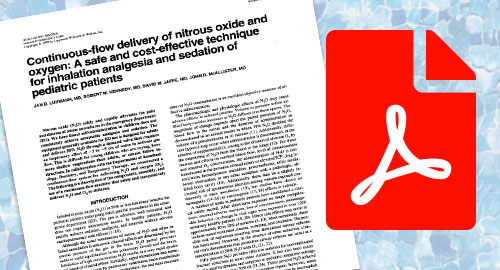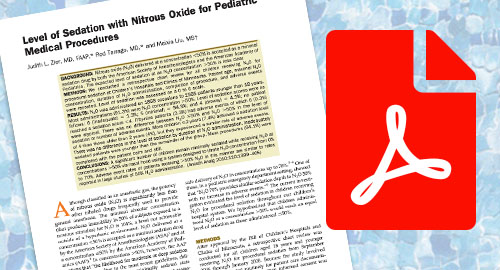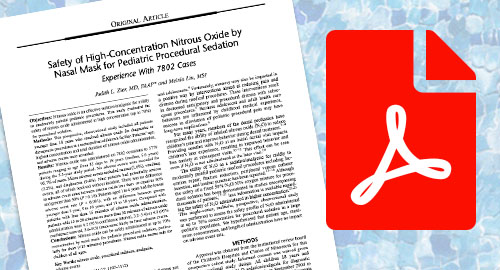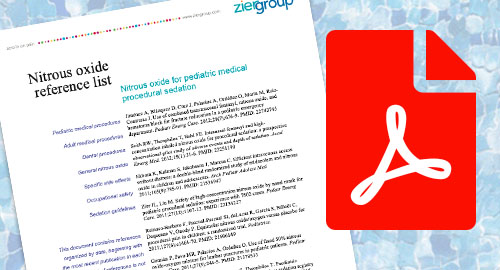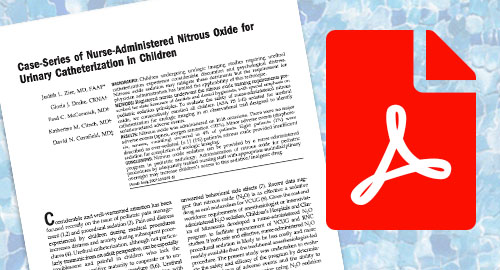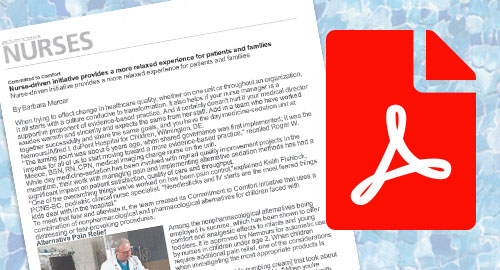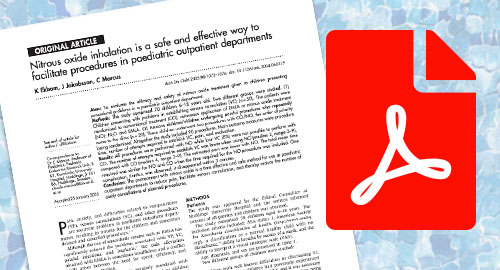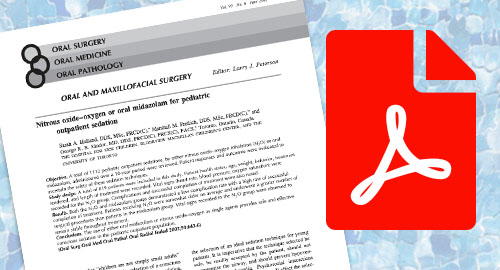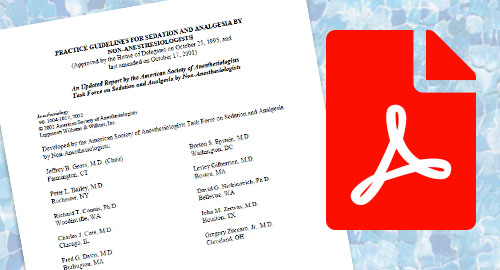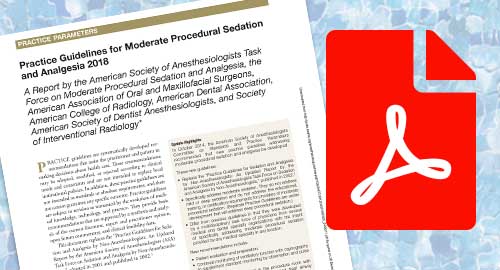Nitrous Oxide (N20) safely and rapidly alleviates the pain and distress of minor procedures in the emergency department (ED). We have found self-administration in children does not consistently achieve acceptable analgesia and sedation.
Nitrous oxide (N2O) delivered at a concentration <50% is accepted as a minimal sedation drug by both the American Society of Anesthesiologists and the American Academy of Pediatrics. The expected level of sedation at an N2O concentration >50% is less clear.
Nitrous oxide is an effective sedative/analgesic for mildly to moderately painful pediatric procedures. This study evaluated the safety of nitrous oxide administered at high concentration (up to 70%) for procedural sedation.
Children undergoing urologic imaging studies requiring urethral catheterization experience considerable discomfort and psychological distress. Nitrous oxide sedation may mitigate these detriments but the requirement for physician administration has limited the applicability of this technique.
When trying to effect change in healthcare quality, whether on one unit or throughout an organization, it all starts with a culture conducive to transformation. It also helps if your nurse manager is a supportive proponent of evidence-based practice.
To evaluate the efficacy and safety of nitrous oxide treatment given to children presenting procedural problems in a paediatric outpatient department.
A total of 1112 pediatric outpatient sedations, by either nitrous oxide–oxygen inhalation (N2O) or oral midazolam, administered over a 10-year period were reviewed. Patient responses and outcomes were evaluated to ascertain the safety of these sedation techniques.
Because Minimal Sedation (“Anxiolysis”) entails minimal risk, the guidelines specifically exclude it. Examples of Minimal Sedation include peripheral nerve blocks, local or topical anesthesia and either (1) less than 50% N2O in O2 with no other sedative or analgesic medications by any route, or (2) a single, oral sedative or analgesic medication administered in doses appropriate for the unsupervised treatment of insomnia, anxiety or pain.
These guidelines focus specifically on the administration of moderate sedation and analgesia for adults and children. The guidelines exclude patients who are not undergoing a diagnostic or therapeutic procedure (e.g., postoperative analgesia). Because minimal sedation (anxiolysis) may entail minimal risk, the guidelines specifically exclude it…
More Resources
Studies
Forms
Miscellaneous
- Luhmann JD, Kennedy RM, Jaffe DM, McAllister JD. Continuous-flow delivery of nitrous oxide and oxygen: a safe and cost-effective technique for inhalation analgesia and sedation of pediatric patients. Pediatr Emerg Care. 1999 Dec;15(6):388-92. doi: 10.1097/00006565-199912000-00004. PMID: 10608322.
- Zier JL, Tarrago R, Liu M. Level of sedation with nitrous oxide for pediatric medical procedures. Anesth Analg. 2010 May 1;110(5):1399-405. doi: 10.1213/ANE.0b013e3181d539cf. Epub 2010 Mar 17. PMID: 20237043.
- Zier JL, Liu M. Safety of high-concentration nitrous oxide by nasal mask for pediatric procedural sedation: experience with 7802 cases. Pediatr Emerg Care. 2011 Dec;27(12):1107-12. doi: 10.1097/PEC.0b013e31823aff6d. PMID: 22134227.
- Zier Group, Nitrous Oxide (N2O) Reference List, October 2012
- Zier JL, Drake GJ, McCormick PC, Clinch KM, Cornfield DN. Case-series of nurse-administered nitrous oxide for urinary catheterization in children. Anesth Analg. 2007 Apr;104(4):876-9. doi: 10.1213/01.ane.0000258763.17768.ce. PMID: 17377099.
- Advances For Nurses, Barbara Mercer, September 12, 2013
- Ekbom K, Jakobsson J, Marcus C. Nitrous oxide inhalation is a safe and effective way to facilitate procedures in paediatric outpatient departments. Arch Dis Child. 2005 Oct;90(10):1073-6. doi: 10.1136/adc.2004.060319. PMID: 16177164; PMCID: PMC1720114.
- Hulland SA, Freilich MM, Sàndor GK. Nitrous oxide-oxygen or oral midazolam for pediatric outpatient sedation. Oral Surg Oral Med Oral Pathol Oral Radiol Endod. 2002 Jun;93(6):643-6. doi: 10.1067/moe.2002.124763. PMID: 12142869.
- Anesthesiology 96: 1004-1017, 2002. © 2002 American Society of Anesthesiologists, Lippincott Williams & Wilkins, Inc.
- Anesthesiology, V 128 • No 3: Copyright © 2018, the American Society of Anesthesiologists, Inc. Wolters Kluwer Health, Inc. All Rights Reserved. Anesthesiology 2018; 128:437–79
Have More Questions?
Call us to find out more about the Nitrouseal® nitrous system. The complete and premium nitrous system.


